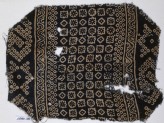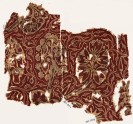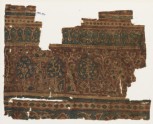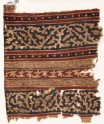Room 5 | Textiles gallery
Explore the beauty and variety of Eastern Art objects on display in the Textiles gallery.

Fragments of splendour
These fragments are among the greatest treasures of the Museum’s textile collections. They were found in Egypt and cover more than 1000 years, from around AD 400 to the 1600s. Culturally, they were part of late Antiquity, early Christianity, and medieval Islamic Egypt.
Looking at textile fragments rather than complete cloths invites a different way of seeing, as details of design and technique stand out. The complexity of weaving, the fineness of embroidery, and the vividness of colour can be appreciated in close focus.
The Newberry Collection
The Ashmolean Museum has the largest collections of medieval Islamic embroideries and Indian block-printed textiles in any public museum worldwide. There are more than 1000 embroideries and over 1200 Indian cotton fragments, dated between AD 900 and 1500. The collection was donated to the Museum in 1941 by the Egyptologist Percy Newberry.
The Islamic Embroideries
There are 1010 embroideries in the collection, most of them fragmentary. The majority are silk embroidered on a linen ground fabric. More than 25 different stitch techniques are used.
Embroidery was a highly developed textile art in the Islamic world, not only used to create patterns, but to inscribe garments given by the ruler to his court. Examples of these so-called tiraz textiles are on display in a case near the Reading and Writing Gallery. The finest of the embroideries were made in specialist textile workshops.
 Textile fragment with scroll tendril and trefoil leaves, probably from a tent (EA1984.100)
Textile fragment with scroll tendril and trefoil leaves, probably from a tent (EA1984.100)
 Textile fragment with naskhi inscription, birds, and palmettes (EA1984.104)
Textile fragment with naskhi inscription, birds, and palmettes (EA1984.104)
 Textile fragment with quatrefoils and interlacing kufic script (EA1984.108)
Textile fragment with quatrefoils and interlacing kufic script (EA1984.108)
 Quilted bag with rosettes, stars, and quatrefoils, probably an amulet-bag (EA1984.125)
Quilted bag with rosettes, stars, and quatrefoils, probably an amulet-bag (EA1984.125)
 Tab from a banner with circles containing a diamond-shape (EA1984.134)
Tab from a banner with circles containing a diamond-shape (EA1984.134)
 Textile fragment with linked diamond-shapes and triangles (EA1984.227)
Textile fragment with linked diamond-shapes and triangles (EA1984.227)
 Textile fragment with linked diamond-shapes, triangles, and palmettes (EA1984.237)
Textile fragment with linked diamond-shapes, triangles, and palmettes (EA1984.237)
 Textile fragment with tendril and leaves (EA1984.265)
Textile fragment with tendril and leaves (EA1984.265)
 Textile fragment with linked diamond-shapes, hexagons, and pseudo-inscription (EA1984.272)
Textile fragment with linked diamond-shapes, hexagons, and pseudo-inscription (EA1984.272)
 Tabs from a banner with fleur-de-lys, blazon, and trefoils (EA1984.35)
Tabs from a banner with fleur-de-lys, blazon, and trefoils (EA1984.35)
 Textile fragment with band of cartouches, spirals, and stars (EA1984.435)
Textile fragment with band of cartouches, spirals, and stars (EA1984.435)
 Roundel textile fragment with repeated inscription and lion (EA1984.44)
Roundel textile fragment with repeated inscription and lion (EA1984.44)
 Textile fragment, possibly from a sash or shawl (EA1984.445.a)
Textile fragment, possibly from a sash or shawl (EA1984.445.a)
 Textile fragment, possibly from a sash or shawl (EA1984.445.b)
Textile fragment, possibly from a sash or shawl (EA1984.445.b)
 Textile fragment, possibly from a sash or shawl (EA1984.445.c)
Textile fragment, possibly from a sash or shawl (EA1984.445.c)
 Textile fragment with squares and hexagons (EA1984.446)
Textile fragment with squares and hexagons (EA1984.446)
 Textile fragment with band of stars (EA1984.472)
Textile fragment with band of stars (EA1984.472)
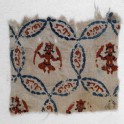 Textile fragment with Jupiter in Pisces or Mercury in Virgo (EA1984.76)
Textile fragment with Jupiter in Pisces or Mercury in Virgo (EA1984.76)
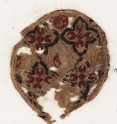 Roundel textile fragment with quatrefoils (EA1984.77)
Roundel textile fragment with quatrefoils (EA1984.77)
 Textile fragment with Maltese crosses (EA1984.84.a)
Textile fragment with Maltese crosses (EA1984.84.a)
 Textile fragment with Maltese cross (EA1984.84.b)
Textile fragment with Maltese cross (EA1984.84.b)
 Textile fragment with heraldic blazon (EA1984.86)
Textile fragment with heraldic blazon (EA1984.86)
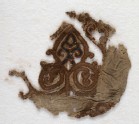 Textile fragment with palmette (EA1984.89)
Textile fragment with palmette (EA1984.89)
 Roundel textile fragment with blazon (EA1984.98)
Roundel textile fragment with blazon (EA1984.98)
 Roundel textile fragment with interlace (EA1984.99)
Roundel textile fragment with interlace (EA1984.99)
 Textile fragment with linked medallions and birds (EA1988.63)
Textile fragment with linked medallions and birds (EA1988.63)
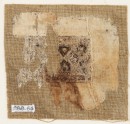 Textile fragment with band of decoration (EA1988.64)
Textile fragment with band of decoration (EA1988.64)
 Textile fragment with band of chevrons and trefoil finials (EA1993.156)
Textile fragment with band of chevrons and trefoil finials (EA1993.156)
Indian Block-printed Textiles
The Indian block-printed textiles came from Gujarat and were exported between the 10th and 16th centuries. They were admired throughout Asia and the Islamic world for their finely spun cotton and their excellent colour-fast dyes.
They were used as garments and as curtains or hangings, as seams, hems, or lappets suggest. Many of the patterns are clearly Indian and have parallels in Gujarati stone and wood carving, but designs with linked chevrons and Arabic inscriptions were produced specifically for the Islamic market.
 Tab from a tent or curtain with stylized plant (EA1990.1079)
Tab from a tent or curtain with stylized plant (EA1990.1079)
 Textile fragment with stylized plants (EA1990.1122)
Textile fragment with stylized plants (EA1990.1122)
 Textile fragment with stylized plants (EA1990.1123)
Textile fragment with stylized plants (EA1990.1123)
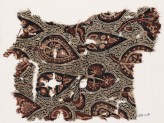 Textile fragment with stylized trees or leaves (EA1990.1128)
Textile fragment with stylized trees or leaves (EA1990.1128)
 Textile fragment with stems, leaves, and blossoms (EA1990.140)
Textile fragment with stems, leaves, and blossoms (EA1990.140)
 Textile fragment with rosettes, arches, stylized trees or flowers, and leaves (EA1990.161)
Textile fragment with rosettes, arches, stylized trees or flowers, and leaves (EA1990.161)
 Tab with stylized flowering plant, rosette, and vine (EA1990.177)
Tab with stylized flowering plant, rosette, and vine (EA1990.177)
 Tab with an ornate plant, tendrils, leaves, and flower-heads (EA1990.181)
Tab with an ornate plant, tendrils, leaves, and flower-heads (EA1990.181)
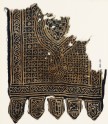 Niche or window cover with medallion and tabs (EA1990.190)
Niche or window cover with medallion and tabs (EA1990.190)
 Textile fragment with arches and flower-heads on tabs (EA1990.230)
Textile fragment with arches and flower-heads on tabs (EA1990.230)
 Textile fragment with serrated crosses (EA1990.43)
Textile fragment with serrated crosses (EA1990.43)
 Textile fragment with serrated crosses (EA1990.496)
Textile fragment with serrated crosses (EA1990.496)
 Textile fragment with interlocking spirals or rosettes (EA1990.509)
Textile fragment with interlocking spirals or rosettes (EA1990.509)
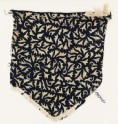 Tab with swirling leaves (EA1990.51)
Tab with swirling leaves (EA1990.51)
 Textile fragment with lotus scroll (EA1990.556)
Textile fragment with lotus scroll (EA1990.556)
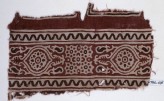 Textile fragment with oval medallions, tendrils, and linked rosettes (EA1990.672)
Textile fragment with oval medallions, tendrils, and linked rosettes (EA1990.672)
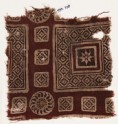 Textile fragment with squares and diamond-shapes (EA1990.728)
Textile fragment with squares and diamond-shapes (EA1990.728)
 Textile fragment with linked medallions (EA1990.744)
Textile fragment with linked medallions (EA1990.744)
See also
Notice
Objects may have since been removed or replaced from a gallery. Click into an individual object record to confirm whether or not an object is currently on display. Our object location data is usually updated on a monthly basis, so contact the Jameel Study Centre if you are planning to visit the museum to see a particular Eastern Art object.
© 2013 University of Oxford - Ashmolean Museum

